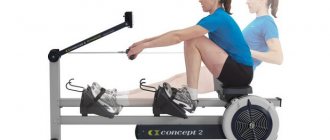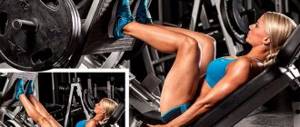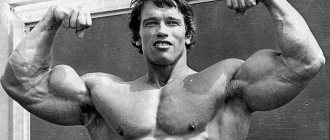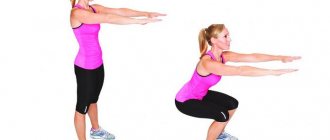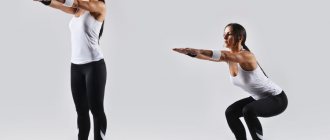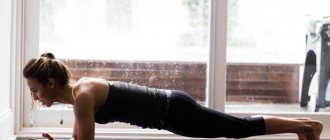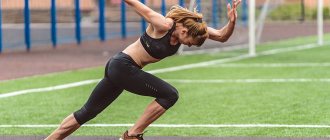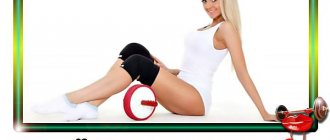Share:
What you need
- Barbell
Front squats with a barbell, or as it is popularly called, the squat with a barbell on the chest, rightfully takes its place of honor among the long-lived exercises. This type of squats has found its admirers in such areas as weightlifting, bodybuilding and crossfit. Many avoid it, but those who have “tried it” can confidently say that the front squat is one of the best exercises for building ideal leg muscles.
It doesn't matter at all what goals you are pursuing. Whether you are looking for hypertrophy or a preference for explosive strength, the front squat with a barbell will help you achieve the desired result. In the material we will analyze all aspects, point out mistakes and give a couple of practical recommendations.
The difference between front squats and regular squats
There are not so many differences, but they are still significant.
Center of gravity
For front squats, the barbell is positioned in front. This means her weight will try to push us back. To avoid this, you will have to strongly strain your abdominal muscles. In the classic version, the barbell will put pressure on us from behind, trying to tilt the body forward. As a result, the entire load shifts to the muscles that hold the spine. We can conclude: in front squats,
the abdominal muscles are more involved, and in regular squats, the lumbar region is more involved.
Less stress on the gluteal muscles
Everything again comes down to the position of our body. IN SQUATS WITH A BAR ON THE SHOULDER, our body is tilted forward. This forces us to move our pelvis back to avoid losing our balance. Consequently, the gluteal muscles will be stretched more strongly and the initial movement during lifting will be due to their effort. In front squats, we keep the body as straight as possible. Therefore, we are not required to move the pelvic area so far. This means that the entire load will go to the knee joint and quadriceps. And in order to stand up, we will have to tense the muscles of the front of the thigh.
Front squats are a more difficult exercise
Unfortunately, keeping the weight in front of you is much more difficult than on your back. Therefore, it will have to be reduced. But don't get upset right away. After all, as soon as you get used to holding the barbell in front and work out the execution technique. It will only be a matter of time before weight gain occurs.
Working weight exercise
Considering that this exercise is basic, it does not tolerate weak or lagging muscles. This means that if you want to increase the weight of the projectile, all the shortcomings of the technique can come out due to lagging links in the form of individual muscle groups.
Therefore, the weight on the bar will be 25%, and maybe even 50% less than in classic squats.
It depends on whether you performed a full descent to the bottom point or not. For example, if your weight was 100 kg in the classical form, and you squat below parallel, the barbell weight on the chest could be 85 kg. If not, it’s better to take 50 kg.
This huge difference is due to the fact that with regular squats the amplitude is partial. There is nothing terrible or shameful in this; work progress will not slow down. After all, better hip development will be achieved while minimizing injury. The barbell squat improves glute activation and allows for greater squat depth.
Muscles worked during front squats
Front squats work a very large muscle mass.
- Quadriceps. This is the front of the thigh. They are the main working muscle. A particularly large part of the load falls on their lateral part (external).
- Biceps femoris. This is the back of our legs. In this exercise, it acts as a stabilizer and works in the negative phase. That is, while lowering the body down.
- Gluteus maximus muscle. I mentioned earlier that in this exercise she receives very little load. But this does not mean that it does not exist at all.
- Adductor muscles of the legs. They actively participate in any exercise where we bend our legs, be it a deadlift or a plie squat. Stabilizes the legs.
- Soleus and gastrocnemius muscles.
These are the muscles of the lower leg. The load on them is static (that is, they do not perform movements). They help us stand steadily on our feet by stabilizing our feet.
These were the leg muscles that take the main or mediocre part in the exercise. But besides them, in squats, the upper part also receives a large load, since we have to hold a large weight of the burden.
- Press. This mainly includes all the muscles in this area, the internal, external obliques and rectus abdominis. They are responsible for stabilizing the body. In this version of squats, they play a very important role.
- Muscles that support the spine. They also stabilize the body by maintaining the spine in the correct position.
- Rhomboid muscles. These are two small muscles responsible for bringing the shoulder blades together. Helps keep your back straight.
All these muscles work as a well-coordinated team. If you exclude any of them, then it is unlikely that you will be able to perform the exercise with the correct technique or avoid injury.
Execution technique
Initial position
- Step up to a power squat rack. Adjust the height of the racks so that the barbell lying on them is at a height below your shoulders. This is done to make it easier to remove the barbell without standing on your toes.
- Get under the barbell. Bring your shoulders forward a little and place the bar on them as close to your neck as possible.
- As for the grip. There are several of them:
First.
It is mainly used in weightlifting and crossfit. It looks like this:
We put our elbows forward and fully bend our arm at the elbow joint. And we place the brushes below the bar.
Or the second one
It is more often used by bodybuilders. It looks like this:
We cross our arms over our chests and grab the bar from above. As if holding the barbell to yourself. Raise your elbows up to the same level as your shoulders. The second option is easier, so beginners are better off starting with it.
- The chin is slightly raised, the gaze is directed upward.
- Remove the bar from the racks and take 1 step back.
- Feet stand shoulder width apart. Feet slightly turned in different directions
This will be the starting position from which we will squat.
Performance:
- Take a deep breath and tighten your core muscles. After this, begin to squat, bending your legs at the knee joint, and moving your pelvis back.
- When you drop just below parallel, pause. That is, the legs are bent more than 90°. As you exhale, forcefully begin to straighten your knees until you return to the starting position.
There is no need to rush while doing squats. Your movements should be smooth and controlled. Feel how your muscles work. Place special emphasis on the quadriceps.
Single leg front squat
One of the best variations of barbell squats is the scissor squat and single-leg lunge.
To perform these exercises, good coordination of movements is required. It is not recommended to immediately move on to the barbell. It is best to start doing such exercises with dumbbells, or with minimal load on the body.
The difference between scissor squats and lunges is that when lunging, you need to take a step forward and maintain balance with a straight back.
When using the scissor squat technique, you need to stand as straight as possible, holding the barbell on your shoulders. You need to take a step forward, touching the floor with one knee. Next, pushing off with the heel of the front leg and the toe of the back leg, we take the starting position.
After each approach, you need to take a break so that your breathing is restored and you can begin a new set of exercises.
Squats to lunges are similar, the only difference is that you need to take a step forward and return to the original position.
Basic errors during execution
Bringing the knees inward
This error most often occurs among beginners. With this technique, it is very easy to lose your balance and fall to one side. Or damage your knee joint. The reasons for knee compression are heavy weight or weak leg muscles. So before adding pounds to the barbell, work on your technique and strengthen your muscles.
Strong turn of toes to the sides
Yes, the socks need to be slightly turned away from each other for a more stable position. But don't get carried away. If you spread them too far apart, they will begin to collapse inward. And then the legs will follow them, which will lead to cramping of the knees. And then you know what can happen. There is a simple rule: socks should point where your knees point. Then you definitely can't go wrong.
Look down
Never look down while performing front squats! If you lower your gaze towards the floor, then by inertia you will begin to lower your elbows there. The back will begin to round behind them, and you will simply drop the barbell. Or you injure your spine.
Excessive weight
I already wrote above what happens when you take too much weight. I would just like to remind you that you came to the gym to get results, not injury. Yes, the main goal in squats is to lift as much weight as possible. But this must be done gradually and wisely. And don’t grab an unbearable burden and cripple your joints and bones.
Relaxed abs
Many people do not tense their abdominal muscles when squatting. And you and I already know that in front squats, this part is given more responsibility for stabilizing the body. This means that the press experiences heavy loads. If you squat with a relaxed stomach, you may simply lean forward. And then the barbell falls, fractures and an injured spine. So make sure to keep your abs in constant tension.
How to avoid these errors?
There are some tips that will help you avoid many mistakes and improve your results in squats.
- Use shoes with hard soles. There are special shoes for bodybuilding and powerlifting. It has a hard and flat sole. It will be easier to keep your balance. And your feet will remain firmly on the ground.
- Tighten your core muscles. How to do this? Draw air into your lungs, and then mentally move it into your stomach. You will immediately feel the tension in your abs. You can also use an athletic belt to start with. It will make it easier for you to feel the tension in the press. As soon as you get used to keeping it tense, immediately remove the belt from your workouts; it will not allow you to properly strengthen your lower back muscles.
- Watch your technique. If you cannot complete one more repetition with proper form, then end the exercise. This way you will avoid injury and will be able to squat for many years to come.
- Increase the weight gradually. To begin, take an empty bar. With it you can easily practice the exercise technique and stretch your muscles, making them more elastic. After this, gradually add weights to the barbell as you progress.
- Breathe correctly. We sit down as we inhale, and stand up as we exhale. This will strengthen your cardiovascular system and keep your core muscles engaged.
- Before working approaches, do a warm-up. This is a mandatory rule! This will warm up our muscles and prepare them for hard work.
- At the end of your workout, do some stretching . This will help relax the muscles and make them more elastic. This rule should not be neglected. It doesn't take much time to stretch.
By following all these tips and avoiding mistakes, you can get good results in front squats.
Good luck to everyone in your training!
READ ALSO:
LEG PRESS IN A MACHINE
LEGS TRAINING
LEG BENDING IN THE SIMULATOR
Contraindications
- Before squatting with a barbell, make sure that you have no contraindications to this type of exercise.
- You should avoid squats if you have had injuries to your knees, feet or spine.
- If you suffer from diseases of the respiratory tract, heart, or blood vessels, it is better to undergo a medical examination, after which the therapist will give recommendations on training.
- Avoid squats if you have recently had surgery.
- Do not exercise if you are sick or just recovered. A weakened body may become worse from such physical activity.
- The load should be increased gradually. You should not start with the heaviest weight (especially for women).
- Before squats, warm up your muscles. These precautions will help prevent injury.
